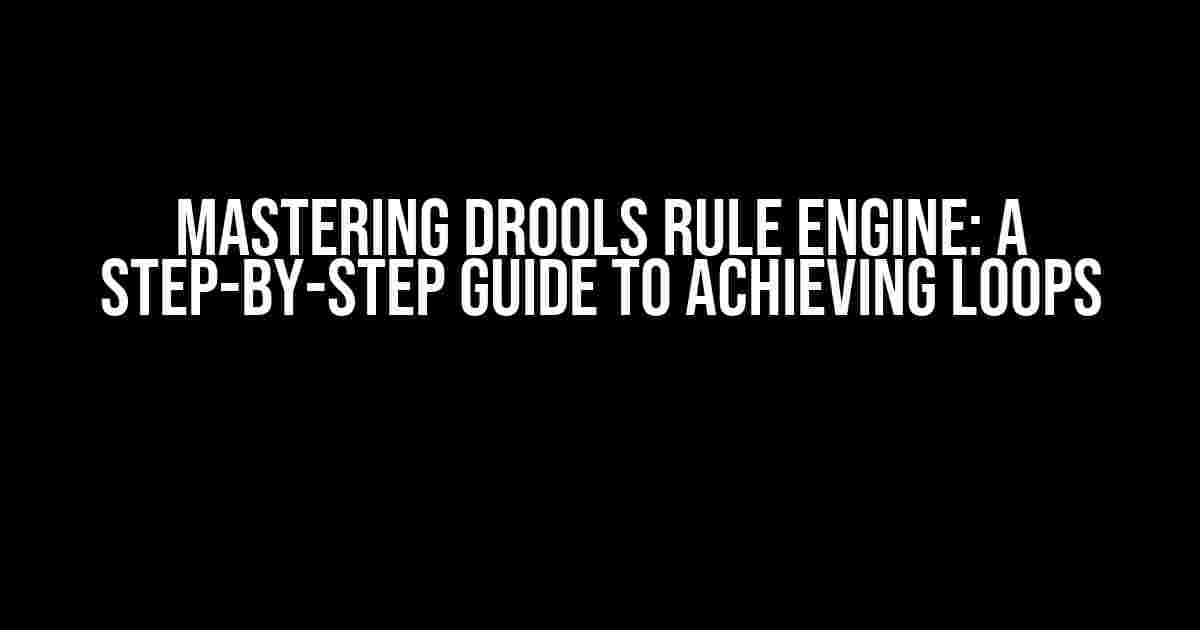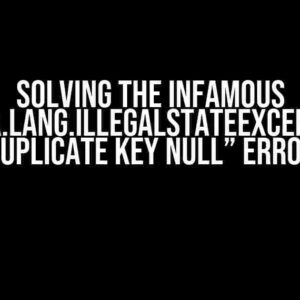If you’re a developer working with Drools Rule Engine, you know how crucial it is to master the art of writing efficient and effective rules. One of the most challenging aspects of Drools is achieving loops, which can be a game-changer for your application’s performance and scalability. In this article, we’ll delve into the world of Drools loops, exploring the what, why, and how of this essential concept.
What is a Loop in Drools?
A loop in Drools refers to a mechanism that allows a rule to iterate over a collection of objects, execute a set of actions, and then repeat the process until a specific condition is met. Think of it as a recursive function, but with a twist – Drools loops work in harmony with the rule engine’s pattern-matching capabilities.
Why Do We Need Loops in Drools?
In Drools, loops are essential for handling complex business logic, data validation, and conditional processing. Without loops, your rules would become cumbersome, inefficient, and prone to errors. With loops, you can:
- Iterate over large datasets with ease
- Perform complex calculations and aggregations
- Enforce business constraints and validity checks
- Optimize rule execution and reduce engine overhead
How to Achieve a Loop in Drools?
Now that we’ve covered the basics, let’s dive into the meat of the matter – achieving loops in Drools. We’ll explore three primary methods: from, collect, and accumulate.
Method 1: Using the from Keyword
The from keyword is the most straightforward way to create a loop in Drools. You can use it to iterate over a collection of objects, like a list or an array.
rule "Looping over a list"
when
$list : List()
$element : String() from $list
then
System.out.println($element);
end
In this example, the rule iterates over a list of strings, printing each element to the console.
Method 2: Using the collect Keyword
The collect keyword is a more advanced way to create a loop in Drools. It allows you to collect a set of objects that match a specific pattern, and then iterate over the collection.
rule "Collecting and looping over a set"
when
$set : Set()
$element : String() from collect( $set )
then
System.out.println($element);
end
In this example, the rule collects a set of strings and then iterates over the collection, printing each element to the console.
Method 3: Using the accumulate Keyword
The accumulate keyword is the most powerful way to create a loop in Drools. It allows you to perform complex calculations and aggregations over a collection of objects.
rule "Accumulating and looping over a list"
when
$list : List()
$sum : int(0)
$element : int() from $list
$sum = $sum + $element
then
System.out.println("Sum: " + $sum);
end
In this example, the rule iterates over a list of integers, accumulating the sum of all elements and printing the final result to the console.
Best Practices for Achieving Loops in Drools
To get the most out of your Drools loops, follow these best practices:
- Use meaningful variable names: Clearly define the purpose of each variable to avoid confusion and improve code readability.
- Optimize your collections: Use efficient data structures, such as arrays or sets, to minimize iteration overhead.
- Minimize rule complexity: Break down complex rules into smaller, more manageable pieces to improve performance and maintainability.
- Test and debug thoroughly: Verify your rules and loops using unit tests and debugging tools to ensure accurate and efficient execution.
Common Challenges and Solutions
When working with Drools loops, you may encounter common challenges, such as:
| Challenge | Solution |
|---|---|
| Performance issues | Optimize collections, reduce rule complexity, and use caching mechanisms. |
| Rule conflicts and ambiguities | Use clear and concise rule definitions, prioritize rules, and implement conflict resolution strategies. |
| Data inconsistencies and errors | Validate data inputs, implement data normalization, and use error-handling mechanisms. |
Conclusion
Achieving loops in Drools Rule Engine is a crucial aspect of building efficient and scalable applications. By mastering the art of loops, you can unlock the full potential of Drools, tackling complex business logic and data processing tasks with ease. Remember to follow best practices, optimize your code, and troubleshoot common challenges to ensure seamless rule execution.
With this comprehensive guide, you’re now equipped to tackle the world of Drools loops with confidence. Happy coding!
Related Resources
- Drools Documentation: Drools Loops
- Drools Tutorials: Getting Started with Drools
- Drools Community Forum: Drools Usage and Development
Frequently Asked Question
Get ready to unravel the mystery of Drools rule engine and learn how to achieve a loop with ease!
What is the primary reason why loops are challenging to implement in Drools rule engine?
The primary reason why loops are challenging to implement in Drools rule engine is that it is designed to evaluate rules in a forward-chaining manner, which makes it difficult to create recursive or iterative logic. However, with the right techniques, you can still achieve looping behavior in Drools!
How can I implement a loop using a recursive rule in Drools?
To implement a loop using a recursive rule in Drools, you can define a rule that matches on a fact, followed by an action that updates the fact, and then re-matches the rule. This process continues until the rule no longer matches, effectively creating a loop. Just be careful not to create an infinite loop!
Can I use a timer to implement a loop in Drools?
Yes, you can use a timer to implement a loop in Drools! You can define a rule that matches on a timer event, and then use the timer to schedule the next iteration of the rule. This approach allows you to create a loop that repeats at a specified interval. Just remember to cancel the timer when the loop is complete!
How can I use a recursive function to implement a loop in Drools?
To use a recursive function to implement a loop in Drools, you can define a Java function that calls itself recursively, and then invoke this function from within a rule. This approach allows you to create a loop that can be controlled and terminated programmatically. Just be mindful of the function call stack to avoid stack overflow!
What are some best practices to keep in mind when implementing loops in Drools?
When implementing loops in Drools, some best practices to keep in mind include: using clear and descriptive rule names, defining explicit termination conditions, avoiding infinite loops, and thoroughly testing your rules to ensure they behave as expected. By following these best practices, you can create efficient and effective loops in Drools!


